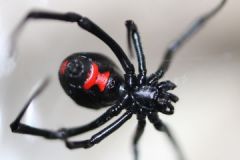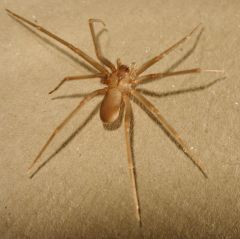![]()
![]()
![]()
Use LEFT and RIGHT arrow keys to navigate between flashcards;
Use UP and DOWN arrow keys to flip the card;
H to show hint;
A reads text to speech;
26 Cards in this Set
- Front
- Back
|
Elapids. Most common effect of toxin? |
Mambas, cobras Ascending paralysis (Neurotoxic) |
|
|
Vipers. Examples? Most common effect of toxin? |
Pit vipers Haemotoxic (think about VHF) |
|
|
Antivenom is lifesaving - why is there a cessation in antivenom supply to Africa? |
Expensive - >$200 a treatment AV causes adverse effects (50% patients) AV is ineffective against local effects. |
|
|
Unsurprisingly. Where does the highest incidence of snakebites occur? |
Where the highest population density conincides with highest snake density.
|
|
|
What occupations are biggest risk factors?
|
Rice farmers, rubber plantations wormers, subsistence farmers. |
|
|
What factors explain why snakebites are low priorities for agencies/research? |
Resource poor countries only affected. Rural populations affected - limited political voice. Patchy geographical problem Many different species and thus many different clinical syndromes/treatments. |
|
|
Some major venom components of snakes? |
Cytotoxins: Proteases, phospholipases Haemorrhagins (Break down of blood vessels) Components acting on clotting cacade and platelets Neurotoxins --> Pre or post synaptics Myotoxins --> May lead to rhabdomyolysis |
|
|
Seasnake bites. Main issue? |
Severe myotoxicity. |
|
|
Clinical pattern of envenoming. (5) |
Some venomous may cause no problems (Up to half of those bitten may have not been envenomed). Bites may not be noticed/reported. Early local Sx --> Pain/Bleeding at bite site --> Swelling/tender LNs Early Sx of systemic envenoming --> Nausea, vomiting, collapse |
|
|
How does snake venom cause coagulopathy? |
Very similar to DIC Consumptive coagulopathy --> All clotting factors used up and then lead to bleeding. |
|
|
How to test for coagulopathy after snake bite? |
Often no access to clotting tests. |
|
|
Neurotoxins 2 different kinds. And why important? |
Pre-synaptic: Prevent transmitter release destruction of nerve terminals Post-synaptic: Toxins bind to acetylcholine receptor. |
|
|
Signs of neurotoxicity after envenomation? (5) |
Close and regular observation necessary Bulbar weakness: Pooling of secretions Progressive weakness Eventual respiratory failure --> Paralysis of intercostal muscles and diaphragm |
|
|
Administering antivenom. Key points |
Slow IV infusion Dose varies between different antivenoms Dose does not depend on size and same amount of venom released. Need to carefully observe antivenom reactions |
|
|
Preventing antivenom reactions: (3) |
Rare of reaction varies considerably depending on sophistication of production. Test dose has no value. |
|
|
Monitoring antivenom. What should be done 4-6 hours after treatment?
|
Check whole blood clotting test. |
|
|
Supportive options with envenoming. (5) |
AIRWAY support. Plasma expanders for hypotension Tetanus vaccine FFP only if antivenom has been given + LIFE threatening bleeding Anticholinersterases --> Useful in some neurotoxic envenomic. |
|
|
Mechanisms of renal failure during envenomation (3)? |
Hypotension, Direct renal toxicity, Myoglobin |
|
|
Some simple ways of preventing snakebite. |
Do not sleep on floor. Use bednet. Cut grass short around campsites. Discourage rats from camps/huts. WEAR BOOTS!! Do not corner snakes. |
|

Clinical features of Latrodectus (Widow spiders) bites? (3) Treatment option? |
Pain --> Local/Regional/Systemic. May have no systemic envenomic Non-specific symptoms --> Hypertension muscles spasms, pulmonary oedema. |
|

Loxosceles spiders (Recluse spiders). |
Mild pain/erythema/swelling. Can be followed by skin necrosis. Systemic manifestations rare. (Include haemolysis and renal failure) Surgical intervention sometimes necessary. |
|

Worst potential for fatality from spider bites? Where found? Treatment? |
Funnel web spiders. Can cause arrhythmias/hypertension/pulmonary oedema. Treatment --> Antivenom available and probably effective |
|
|
Scorpion stings. Where do venoms tend to act? Clinical presentation? |
Venoms act on Na/K channels of neuromuscular tissue
Clinical manifestations: Severe pain, slight swelling. |
|
|
MGMT of scorpion stings? (4) |
Antivenom Atropine for bradys Prazosin for some CVS manifestations Supportive therapy for heart failure. |
|
|
Mechanism of envenomation from jellyfish? |
Mechanical contact with nematocysts on tentacles causes injection of venom into prey. -Chironex (box jellyfish) may cause myalgia, panic, HTN, pulmonary oedema and autonomic disturbance. -Irukandji syndrome --> Limited local symptoms but late severe generalised pain and HTN |
|
|
Marine envenoming from fish spines. |
Sx - Extreme pain!!!! Some cause systemic envenoming. Tx --> Immerse in hot water and possibly nerve block. |

